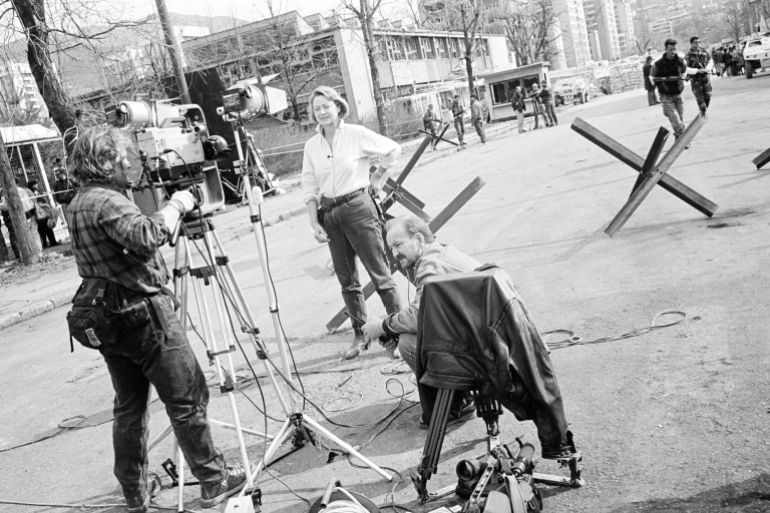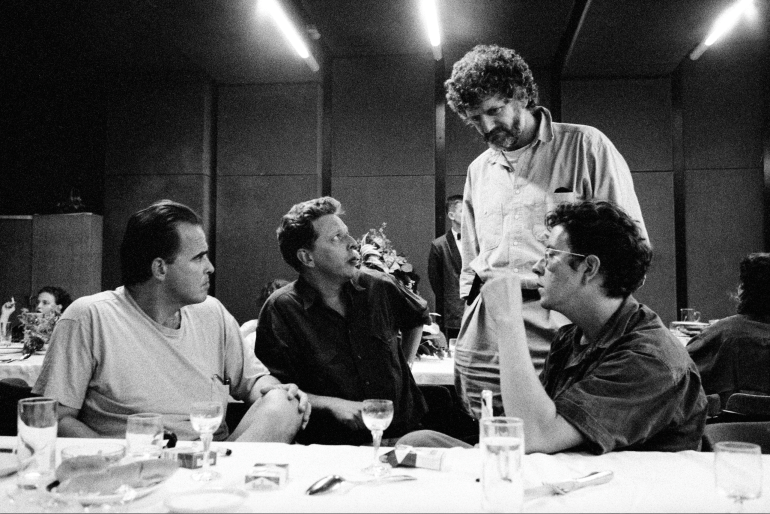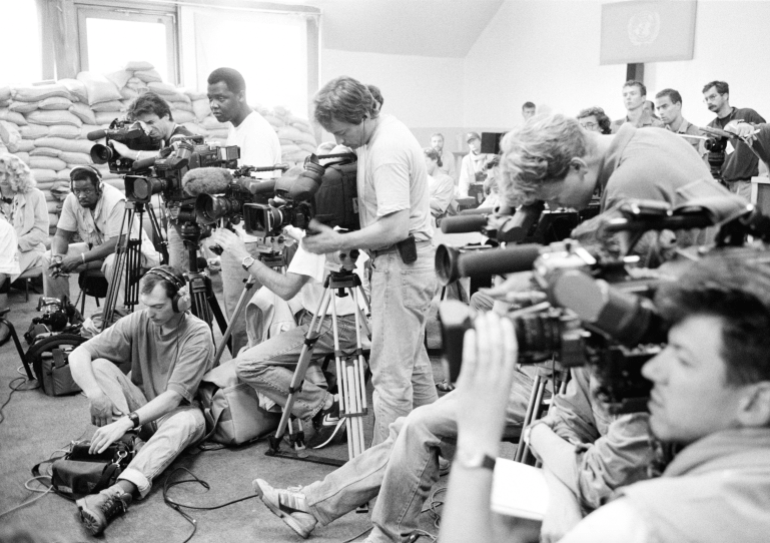How the siege of Sarajevo changed war reporting
The siege of Sarajevo, which began 29 years ago this month, led to the creation of a journalistic infrastructure – from the use of armoured cars and flak jackets to digital technology and live satellite broadcasts – that allowed the story to reach a worldwide audience.

This month marks 29 years since the beginning of the 1992-1995 war in Bosnia and Herzegovina and the siege of Sarajevo, during which the city was militarily encircled and subjected to daily sniping, mortaring and shelling, first by the the Yugoslav People’s Army (JNA) and subsequently by the Army of Republika Srpska (VRS).
The siege lasted 1,425 days, making it the longest siege in modern history, and killed more than 11,000 people. Many of the city’s most important cultural institutions, historical monuments, sporting venues and the wider social and economic infrastructure were destroyed or seriously damaged. Ordinary citizens, already suffering the privations caused by the cutting-off of gas, electricity and water supplies, were not only caught in the crossfire but deliberately targeted by shell and sniper fire.
Keep reading
list of 4 itemsSarajevo under siegeThis article will be opened in a new browser window
‘A camera doesn’t lie’: Documenting besieged Sarajevo
The Love of Books: The Brave Librarians of Sarajevo
The siege of Sarajevo thus became worldwide news. The international media portrayed it as a compelling struggle between David and Goliath; the lightly-armed defenders of a city encircled by the might of the remnants of the VRS. Compounding this was the visceral imagery of a place the wider public knew primarily as the host city of the 1984 Winter Olympic Games. And for those foreign correspondents who reported from Sarajevo during the siege, it became the most important story of their careers and a significant number remained committed to the story until the lifting of the siege in February 1996.
Changing the way journalists worked
While a number of experienced journalists, such as the BBC’s Martin Bell and the Pulitzer Prize-winning John F Burns of the New York Times, made significant contributions, those of the younger generation were equally notable. Kurt Schork of Reuters, Christiane Amanpour of CNN and Allan Little of the BBC were among those that made their names in Bosnia and Herzegovina, while many young and less experienced journalists and photographers, some operating as freelancers, stringers or “super-stringers” learned their craft in Sarajevo, one which changed significantly over that four-year period.

The advent of digital technology began to change the way they worked, the use of armoured cars, flak jackets and helmets became more widespread, as did live satellite broadcasts and the inexorable path towards the “tyranny of the two-way” broadcast. Indeed, many of the practices developed in Sarajevo during the siege would become standard in war reporting thereafter. And, in this particular context, a demonstration of remarkable solidarity in the form of the Sarajevo Agency Pool, which facilitated the “pooling” of footage so that TV crews, in particular, could limit their exposure to unnecessary risk.
Perhaps the most remarkable aspect of reporting on the siege of Sarajevo was, however, the relatively rapid development of the journalistic infrastructure that facilitated the work of these foreign correspondents. Between April and June 1992, there was little in the way of any such infrastructure, though one would emerge and consolidate by the late summer of 1992.
By then, Sarajevo had become something of a second home for many foreign correspondents and the city became the primary lens through which most outsiders viewed the war in Bosnia and Herzegovina. Indeed, by July 1992 buildings such as the Holiday Inn, the Sarajevo TV station – where the European Broadcasting Union (EBU) established a satellite feed point – the PTT building where UN briefings took place, and the city’s airport from where journalists could fly in and out of Sarajevo, had become part of a vital infrastructure that journalists used to send their daily reports on developments within the besieged city.
Getting into Sarajevo: From ‘Maybe Airlines’ to ‘Sniper Alley’
In the early months of the siege, foreign correspondents based in Sarajevo were relatively few in number and scattered across the city – some in private accommodation, others in small hotels that were, at that point at least, still operational. The majority, however, were based in the hotel complex in Ilidža, where the EBU had established their first satellite feed point, until they were forced to evacuate in mid-May 1992. As a consequence, there were only a small number of foreign reporters and photojournalists in Sarajevo throughout much of the following month. This was, in part, because getting in and out of the city in the early months of the siege was both difficult and fraught with danger. Those attempting to do so went by car via either the Pale-Lukavica road (and then across the exposed airport runway) or the Kiseljak-Ilidža road – both of which presented significant hazards and numerous checkpoints to navigate – or, later, the Mount Igman road.
With the re-opening of Sarajevo airport at the end of June 1992, after UNPROFOR had taken control of it, journalists could access the city more easily. Once in possession of a UN press pass, they could fly directly into Sarajevo airport. Thus, the “air bridge” that allowed aid to be flown into the city also served as a shuttle service for card-carrying correspondents and from the beginning of July 1992, many of those who arrived in the city did so via UN aid flights – sardonically dubbed as “Maybe Airlines” – from Zagreb and Split in Croatia or Ancona in Italy.

Flying into the city, usually on a Hercules C-130, involved a “Khe Sanh approach”, a technique developed by the US Air Force during the Vietnam War in which the plane would nosedive into a sharp descent and level off just before landing. Once at the airport, journalists then had to travel into the city down the treacherous airport road onto what became known as “Sniper Alley”, the main artery into Sarajevo. Numerous journalists were either killed or seriously injured taking this route, including David Kaplan, the ABC senior news producer, who was fatally wounded by a sniper’s bullet on August 13, 1992, minutes after arriving in Sarajevo and the CNN camerawoman, Margaret Moth, who was seriously injured on Sniper Alley on July 23, 1992. Both were travelling in “soft-skin” vehicles, which afforded little or no protection. By the late summer of 1992, a greater number of journalists were acquiring armoured cars, which were increasingly regarded as necessary for operating within a besieged city.
The Holiday Inn: Sarajevo’s ‘war hotel’
Every conflict has its “war hotel” and in Sarajevo it was the Holiday Inn, which became the home for many foreign correspondents and TV crews, with a few notable exceptions – the Associated Press were, for example, based in the Hotel Belvedere – and a crucial networking node. The hotel, which had been the temporary base for Radovan Karadžić and the leadership of the Serbian Democratic Party (SDS), had been closed after April 6, 1992, when SDS snipers fired shots into a crowd of peaceful demonstrators assembled outside the Bosnian parliament before the hotel was stormed by Bosnian special forces. The interior of the building was badly damaged by the events of that day, but by late May 1992 what remained of the hotel’s staff returned to work to prepare for its re-opening in late June.
The Holiday Inn was no haven for its wartime guests, most of whom were journalists. It was dangerously exposed to mortar and sniper fire and located not only within siege lines but directly facing the front line and within what became known as “Sniper’s Corner”, the most dangerous part of Sniper Alley. Many parts of the building were exposed to sniper fire, the lobby windows were no more than dangling shards of glass or open spaces covered with tarpaulin, and virtually every window on the building had been damaged by gunfire.

Nevertheless, by July 1992, the Holiday Inn had emerged as a crucial communications hub for foreign journalists and the local staff – translators, fixers, drivers – that were hired by them. While life there was not, strictly speaking, a comfortable one, the guests did not suffer the daily privations experienced by the citizens of Sarajevo. The hotel had an underground car park where vehicles could be safely kept, and it provided food and a relatively stable supply of water and electricity. This made it, however, very expensive and inaccessible to freelancers, who tended to reside in cheaper private accommodation.
‘A grey concrete structure’: The Sarajevo TV building
Like the Holiday Inn, the Sarajevo TV building was also a vital part of the infrastructure used by the foreign press corps; and while there was some communications equipment within the hotel, it was from the TV station that the vast majority of reports by foreign journalists were filed or transmitted. Built in the 1970’s but extended in advance of the 1984 Winter Olympics, this large grey concrete structure was among the least aesthetically pleasing, though one of the most solidly constructed, buildings in the city.
Throughout April and May 1992, the TV station was the home primarily for Radio Television of Bosnia and Herzegovina (RTV-BiH). But after the EBU evacuated their base – and left their equipment – at the Hotel Ilidža in May 1992, a small EBU “special operations team” returned to Sarajevo in June and established a new “feed point” in the TV station. This became a critical part of the journalistic infrastructure, where TV crews, radio journalists and print journalists would all send their footage by satellite or dictate reports using satellite phones.

The TV station was considered one of the most secure buildings in the city and its robust construction determined that it could withstand the shelling and mortar attacks that it regularly endured. It remained, throughout the siege, a hugely important part of the reporting infrastructure, without which television images of the siege of Sarajevo and the privations of citizens would not have been as widely disseminated to international audiences.
The worst of the attacks on the TV station came on the morning of June 28, 1995, when a large explosion, caused by an improvised “air bomb” fired from Ilidža, killed one and injured tens of both locals and foreigners working in the building. Numerous offices used by foreign media agencies were badly damaged, including the EBU’s editing room and feed point – though, incredibly, their equipment still functioned.
The ‘Nine O’Clock Follies’
The Postal, Telegraph and Telephone (PTT) building, where the UN held their press briefings, was also an important part of the broader infrastructure used by journalists. UNPROFOR had used one floor of the building between March and May 1992, though the majority of their personnel were based at what they dubbed the “Hotel Rainbow” – a newly-built home for the elderly painted in bright colours – before their temporary withdrawal in May 1992. That building had been badly damaged in June 1992, so after their return, they established a base in the PTT Engineering building in the Alipašino polje district.

One of the daily rituals of the foreign press corps in Sarajevo was to attend these daily briefings, dubbed the “Nine O’Clock Follies”, a play on the “Five O’Clock Follies” delivered by the US Army in the Rex Hotel in Saigon during the Vietnam War. They were often rather fractious affairs, with gathered journalists sometimes critical of the role of the UN. Briefings for the press were also held at the Bosnian Presidency building, and this, too, became one of the key places for journalists to garner information.
This journalistic infrastructure, therefore, ensured that the story of the siege of Sarajevo, both in terms of military developments and the experiences of the citizens, could continue to be conveyed to worldwide audiences, though there was dismay within the international press corps that their reporting did not lead to an intervention that would end the siege.
Creating that infrastructure was a significant logistical and technological endeavour undertaken in the most challenging of circumstances. The repurposing of key buildings in the city as places where the media could gather official information or use communications equipment to file copy or transmit images, the increasing use of armoured vehicles to navigate more safely within the city and a genuine commitment to the story all combined to ensure that the siege remained, albeit only periodically, on the international news agenda until it was lifted in February 1996.